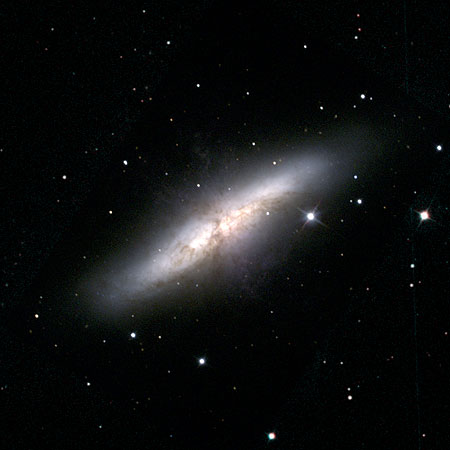NASA Ames Research Center | PR 10-65AR | 02 Aug 2010
NASA scientists created a unique collection of Polycyclic Aromatic Hydrocarbon (PAH) spectra to interpret mysterious emission from space. Because PAHs are a major product of combustion, remain in the environment, and are carcinogenic, the value of this PAH spectral collection extends far beyond NASA and astronomical applications.
- [i]Visible (above; Hubble Space Telescope) and combined visible-infrared (below; Spitzer Space Telescope) images of the galaxy Messier-82 (M82), also known as the Cigar Nebula because of its cigar-like shape in the visible. The red streaming away from the galaxy into intergalactic space traces the infrared emission from PAHs.[/i]
For years, scientists have been studying a mysterious infrared glow from the Milky Way and other galaxies, radiating from dusty regions in deep space. By duplicating the harsh conditions of space in their laboratories and computers, scientists have identified the mystifying infrared emiters as PAHs. PAHs are flat, chicken-wire shaped, nano-sized molecules that are very common on Earth.
“PAHs in space are probably produced by carbon-rich, giant stars. A similar process produces soots here on Earth,” said Louis Allamandola, an astrochemistry researcher at NASA’s Ames Research Center, Moffett Field, Calif. “Besides astronomical applications, this PAH database and software can be useful as a new research tool for scientists, educators, policy makers, and consultants working in the fields of medicine, health, chemistry, fuel composition, engine design, environmental assessment, environmental monitoring, and environmental protection.”
To manage the research data, NASA built a database that now can be shared over the internet. It’s the world’s largest collection of PAH infrared data, and the website contains nearly 700 spectra of PAHs in their neutral and electrically charged states. In addition, it has tools to download PAH spectra ranging in temperature from minus 470 to 2000 degrees Fahrenheit. Thanks to these spectra, PAHs are now known to be abundant throughout the universe, but in exotic forms not readily found on Earth.
This mysterious infrared radiation from interstellar space was discovered in the 1970’s and 1980’s. While the infrared signature hinted that PAHs might be responsible, laboratory spectra of only a handful of small, individual PAHs were available to test this idea. To make matters worse, these were only for neutral, solid PAHs, not representive for PAHs as they would be in space, where they’d be electrically charged, very cold, individual molecules floating in the gas.
By the mid-1990's, observations showed this infrared emission as surprisingly common and widespread across the universe, implying that the unknown carrier was abundant and important. To better understand PAHs, then thought to be too complex to be present in space, their spectra were measured under astronomical conditions.
PAH Spectral Database -- PR


